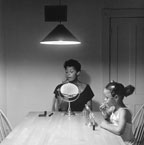Urban Dictionary
Here's a short article I wrote for City newspaper on internet oddity, UrbanDictionary.com:
Read here, or below:
Think you're hip? Can you understand the mock conversation below?
Bob: Man, I have such a food baby! Djeetyat?
Jill: No. The cinemuck really turned my scrangina.
Bob: Shaw, it was skody! Let's globnick.
Jill: Sounds like a larf.
If you have no idea what Bob and Jill are discussing, then you obviously haven't been introduced to UrbanDictionary.com, an online community-edited slang dictionary. Started by Aaron Peckham in 2001, the website boasts more than 1 million entries, and almost 2,000 new ones are added each day. New entries are frequently repeats, and the site allows users to vote on entries (thumbs up or thumbs down) so that entries with higher ratings take prominence on the page.
Many of the words and phrases featured on UrbanDictionary.com are common sayings (like "cool"), some were derived from television, movies, or other pop-culture venues (and Urban Dictionary does its best to note the origins). Some entries are instances of offbeat vernacular, and at times, they are simply words made up by the site's users.
Most Gen-X and Gen-Y'ers will recognize terms like "drunk-dialing," defined by Urban Dictionary as making a phone call while inebriated to former flings, ex-boyfriends or girlfriends, or guys or girls that you want to hook up with; "shoulder surfing," looking over the shoulder(s) of a person with whom you are currently engaged in conversation to see if you can find someone better to talk to; or "rock star parking," the rare occurrence of obtaining a parking space directly outside the door of a bar, club, or restaurant.
But other words and expressions, like the ones used in the mock conversation above, are so new that they haven't yet made our everyday vocabulary. This is why Urban Dictionary's cultural role is twofold. It serves as a reference for individuals (and often businesses trying to market to younger, hip audiences). And as a continually updated database, it actually works to create new cultural expressions instead of being a mere reference for existing urban slang.
In the fall of 2005, Urban Dictionary expanded from just a website to a printed reference guide. The 352-page book contains only about 2,000 definitions from the website's massive collection. With online updates taking place daily, the book was outdated before it is even released. In other words, it is so five minutes ago.
Check it out at www.urbandictionary.com. It's da bomb.
Read here, or below:
Think you're hip? Can you understand the mock conversation below?
Bob: Man, I have such a food baby! Djeetyat?
Jill: No. The cinemuck really turned my scrangina.
Bob: Shaw, it was skody! Let's globnick.
Jill: Sounds like a larf.
If you have no idea what Bob and Jill are discussing, then you obviously haven't been introduced to UrbanDictionary.com, an online community-edited slang dictionary. Started by Aaron Peckham in 2001, the website boasts more than 1 million entries, and almost 2,000 new ones are added each day. New entries are frequently repeats, and the site allows users to vote on entries (thumbs up or thumbs down) so that entries with higher ratings take prominence on the page.
Many of the words and phrases featured on UrbanDictionary.com are common sayings (like "cool"), some were derived from television, movies, or other pop-culture venues (and Urban Dictionary does its best to note the origins). Some entries are instances of offbeat vernacular, and at times, they are simply words made up by the site's users.
Most Gen-X and Gen-Y'ers will recognize terms like "drunk-dialing," defined by Urban Dictionary as making a phone call while inebriated to former flings, ex-boyfriends or girlfriends, or guys or girls that you want to hook up with; "shoulder surfing," looking over the shoulder(s) of a person with whom you are currently engaged in conversation to see if you can find someone better to talk to; or "rock star parking," the rare occurrence of obtaining a parking space directly outside the door of a bar, club, or restaurant.
But other words and expressions, like the ones used in the mock conversation above, are so new that they haven't yet made our everyday vocabulary. This is why Urban Dictionary's cultural role is twofold. It serves as a reference for individuals (and often businesses trying to market to younger, hip audiences). And as a continually updated database, it actually works to create new cultural expressions instead of being a mere reference for existing urban slang.
In the fall of 2005, Urban Dictionary expanded from just a website to a printed reference guide. The 352-page book contains only about 2,000 definitions from the website's massive collection. With online updates taking place daily, the book was outdated before it is even released. In other words, it is so five minutes ago.
Check it out at www.urbandictionary.com. It's da bomb.



